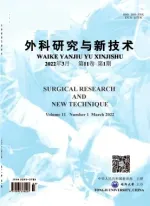The application of C1-C2 pedicle screw internal fixation on the upper cervical diseases of chil-dren
夏 虹(Xia Hong,Dept Orthop,Guangzhou Gen Hosp Guangzhou Mil Command,Guangzhou,Guangdong 510010)…∥Chin J Clin Basic Orthop Res.-2010,2(3).-181~185
The application of C1-C2 pedicle screw internal fixation on the upper cervical diseases of chil-dren
夏 虹(Xia Hong,Dept Orthop,Guangzhou Gen Hosp Guangzhou Mil Command,Guangzhou,Guangdong 510010)…∥Chin J Clin Basic Orthop Res.-2010,2(3).-181~185
ObjectiveTo report five cases of puerile(<9 years)atlantoaxial instability which underwent C1-C2 pedicle screw internal fixation by posterior approach,and to introduce the surgical technique and the key point of intra-and post-operative management.MethodsThe average age of the five cases(1 male and 4 female)was 77.6 months(2 years to 9 years and 8 months old).All cases had atlantoaxial instability,one with dens tumor,one with atlantoaxial trauma,and three with dysplasia.All of the cases had syndromes of neck pain,limitation of cervical motion,and tetraparesis in different degrees due to the compression of spinal cord.Cervical X-ray including dynamic position,MRI,and three-dimension CT scanning were performed preoperatively.The computer aided design-rapid prototyping(CAD-RP)technique was utilized with the data from the three-dimension CT to create the atlantoaxial and pedicle screw drill models.The screw placement procedure was monitored by fluoroscopy.The case with dens tumor underwent posterior instrumentation followed by transoral tumor resection.ResultsAll of the operations were successful with no complications.The average estimated blood loss was 100 ~ 300 mL.The CT scanning showed the screws were in good position.Follow-up at 3 ~6 months demonstrated all of the patient significant recovery and no complication happened.ConclusionThe technique of pedicle screw internal fixation with 3.5 mm screw could be applied to the atlantoaxial instability of children.With the help of C-arm,3D CAD and drill guide models,the anchor of the screws would be more accurate.16 refs,2 figs.
(Authors)
- 外科研究与新技术的其它文章
- Treatment for 63 cases of the elderly with choledocholith by duodenoscope
- Selection of surgical methods for thoracic ossification of ligamentum flavum combined with cervi-cal spondyoti meth
- Free-hand cervical pedicle screw fixation for upper cervical fracture and instability
- Atlantoaxial pedicle screw system for treatment of unstable atlantoaxial dislocation post traction
- One stage anterior release and posterior fusion for the treatment of irreducible atlantoaxial dislocation secondary to os odontoideum
- Three-dimensional analysis of pedicle screw channel,screw entry point and lateral surface of cervi-cal vertebr body

